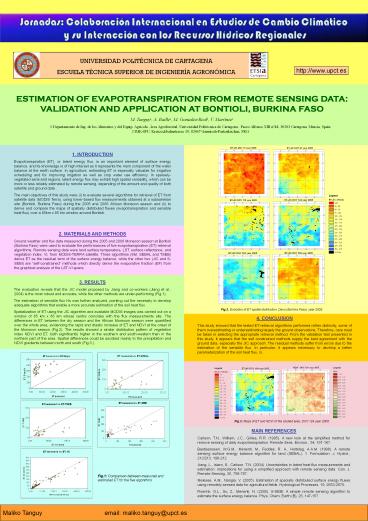Maliko Tanguyemail: maliko.tanguy@upct.es - PowerPoint PPT Presentation
1 / 1
Title:
Maliko Tanguyemail: maliko.tanguy@upct.es
Description:
... during the 2005 and 2006 Monsoon season at Bontioli (Burkina ... Fig.2: Evolution of ET spatial distribution, Dano (Burkina Faso), year 2005. 4. CONCLUSION ... – PowerPoint PPT presentation
Number of Views:62
Avg rating:3.0/5.0
Title: Maliko Tanguyemail: maliko.tanguy@upct.es
1
UNIVERSIDAD POLITÉCNICA DE CARTAGENA ESCUELA
TÉCNICA SUPERIOR DE INGENIERÍA AGRONÓMICA
http//www.upct.es
ESTIMATION OF EVAPOTRANSPIRATION FROM REMOTE
SENSING DATA VALIDATION AND APPLICATION AT
BONTIOLI, BURKINA FASO M. Tanguy1, A. Baille1, M.
Gonzalez-Real1, V. Martínez1 1 Departamento de
Ing. de los Alimentos y del Equip. Agrícola. Área
Agroforestal. Universidad Politécnica de
Cartagena. Paseo Alfonso XIII nº48, 30203
Cartagena, Murcia, Spain 2 IMK-IFU,
Kreuzeckbahnstrasse 19, 82467 Garmisch-Partenkirch
en, FRG
1. INTRODUCTION Evapotranspiration (ET), or
latent energy flux, is an important element of
surface energy balance, and its knowledge is of
high interest as it represents the main component
of the water balance at the earth surface. In
agriculture, estimating ET is especially valuable
for irrigation scheduling and for improving
irrigation as well as crop water use efficiency.
In sparsely-vegetated semi-arid regions, latent
energy flux may exhibit high spatial variability,
which can be more or less reliably estimated by
remote sensing, depending of the amount and
quality of both satellite and ground data . The
main objectives of this study were (i) to
evaluate several algorithms for retrieval of ET
from satellite data (MODIS Terra), using
tower-based flux measurements obtained at a
subsahelian site (Bontioli, Burkina Faso) during
the 2005 and 2006 African Monsoon season and (ii)
to derive and compare the maps of spatially
distributed fluxes (evapotranspiration and
sensible heat flux) over a 85km x 85 km window
around Bontioli. 2. MATERIALS AND
METHODS Ground weather and flux data measured
during the 2005 and 2006 Monsoon season at
Bontioli (Burkina Faso) were used to evaluate the
performances of five evapotranspiration
(ET)-retrieval algorithms. Remote sensing data
were land surface temperature, LST, surface
reflectance, and vegetation index, VI, from
MODIS-TERRA satellite. Three algorithms (SM,
SEBAL and TSEB) derive ET as the residual term of
the surface energy balance, while the other two
(JIC and S-SEBI) are self-constrained methods
which directly derive the evaporative fraction
(EF) from the graphical analysis of the LST-VI
space. 3. RESULTS The evaluation reveals that
the JIC model proposed by Jiang and co-workers
(Jiang et al., 2004) is the most robust and
accurate, while the other methods are
under-performing (Fig.1). The estimation of
sensible flux Hs was further analyzed, pointing
out the necessity to develop adequate algorithms
that enable a more accurate estimation of the
soil heat flux. Spatialization of ET using the
JIC algorithm and available MODIS images was
carried out on a window of 85 km x 85 km whose
centre coincides with the flux measurements site.
The differences in ET between the dry season and
the African Monsoon season were quantified over
the whole area, evidencing the rapid and drastic
increase of ET and NDVI at the onset of the
Monsoon season (Fig.2). The results showed a
similar distribution pattern of vegetation index
NDVI and ET, both significantly higher in the
southern and south-western than in the northern
part of the area. Spatial differences could be
ascribed mainly to the precipitation and NDVI
gradients between north and south (Fig.3.).
Fig.2 Evolution of ET spatial distribution, Dano
(Burkina Faso), year 2005.
4. CONCLUSION This study showed that the tested
ET-retrieval algorithms performed rather
distinctly, some of them overestimating or
underestimating largely the ground observations.
Therefore, care must be taken in selecting the
appropriate retrieval method. From the validation
test presented in this study, it appears that the
self constrained methods supply the best
agreement with the ground data, especially the
JIC approach. The residual methods suffer from
errors due to the estimation of the sensible
flux. In particular, it appears necessary to
develop a better parameterization of the soil
heat flux, G.
Fig.3 Maps of ET and NDVI of the studied area,
DOY 124 year 2005.
MAIN REFERENCES Carlson, T.N., William, J.C.,
Gillies, R.R. (1995). A new look at the
simplified method for remove sensing of daily
evapotranspiration. Remote Sens. Environ., 54,
161-167. Bastiaanssen, W.G.M., Menenti, M.,
Feddes, R. A., Holtslag, A.A.M. (1998). A remote
sensing surface energy balance algorithm for land
(SEBAL). 1. Formulation. J. Hydrol., 212/213,
198-212. Jiang, L., Islam, S., Carlson, T.N.
(2004). Uncertainties in latent heat flux
measurements and estimation implications for
using a simplified approach with remote sensing
data. Can. J. Remote Sensing, 30,
769-787. Melesse, A.M., Nangia, V. (2005).
Estimation of spacially distributed surface
energy fluxes using remotely-sensed data for
agricultural fields. Hydrological Processes, 19,
2653-2670. Roerink, G.L., Su, Z., Menenti, N.
(2000). S-SEBI A simple remote sensing algorithm
to estimate the surface energy balance. Phys.
Chem. Earth (B), 25, 147-157.
Maliko Tanguy email maliko.tanguy_at_upct.es






























